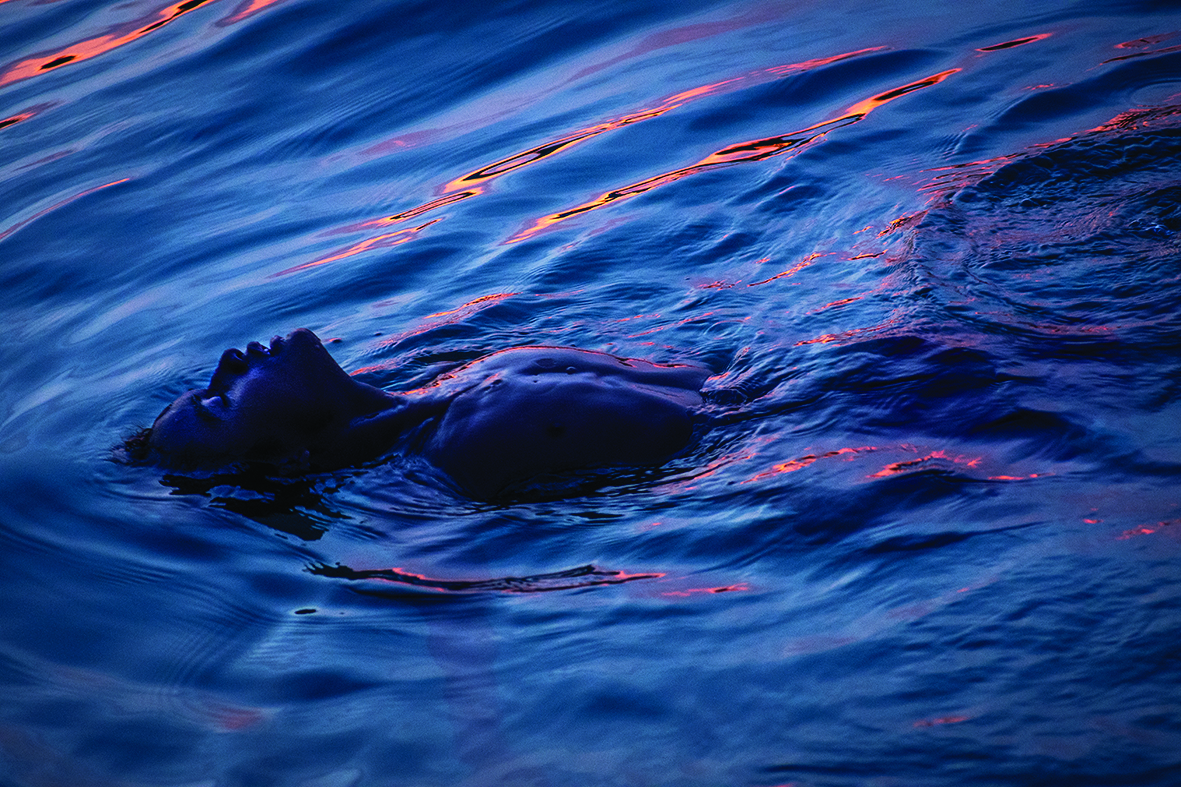No-one could accuse emerging Australian director Rodd Rathjen of a lack of ambition. They could, perhaps, accuse him of a little too much ambition. His soulful second short, Tau Seru (2013), depicts a young sheep-herder and his father eking out a living in the foothills of the Himalayas. Inspired by his travels through India – where he witnessed the sparse lives of nomads outside the desert city of Leh in the fractious Kashmir region contested by Pakistan – it was shot at a dizzying altitude of 4000 metres and required Rathjen to contend with a significant language barrier. When Tau Seru was selected for the 2013 Cannes Film Festival[1]It was one of only two Australian titles slated for the festival that year, alongside opening-night (non-competition) film The Great Gatsby (Baz Luhrmann, 2013). – where it would be showcased during Critics’ Week and nominated for the Discovery Award – Rathjen told Screen Australia of the filming experience, ‘I think we were all feeling that we had bitten off more than we could chew.’[2]Rodd Rathjen, quoted in ‘Australian Short Tau Seru Selected for Cannes’, media release, Screen Australia, 23 April 2013, <https://www.screenaustralia.gov.au/sa/media-centre/news/2013/04-23-tau-seru-selected-for-cannes>, accessed 30 October 2019.
He’s still biting – and his debut feature, Buoyancy (2019), has raised the stakes considerably. Premiering at last year’s Berlin International Film Festival before having its Australian debut at the Melbourne International Film Festival (MIFF), it depicts the hopes and dreams of fourteen-year-old Chakra (Sarm Heng). Frustrated by his family life and toiling away in the rice fields of Cambodia, Chakra soon rails against his father and their grinding poverty. With his feet itchy, much like the young lad at the heart of Tau Seru, he decides to seek out factory work in Thailand, but this proves disastrous, damning him instead to a dire fate. Sold into slavery, he and fellow captive Kea (Mony Ros) are set to work on a fishing trawler under merciless captain Rom Ran (Thanawut Kasro), himself a former child slave. A tangled net is then cast around these players as their situations become ever more desperate and fights for survival intensify.
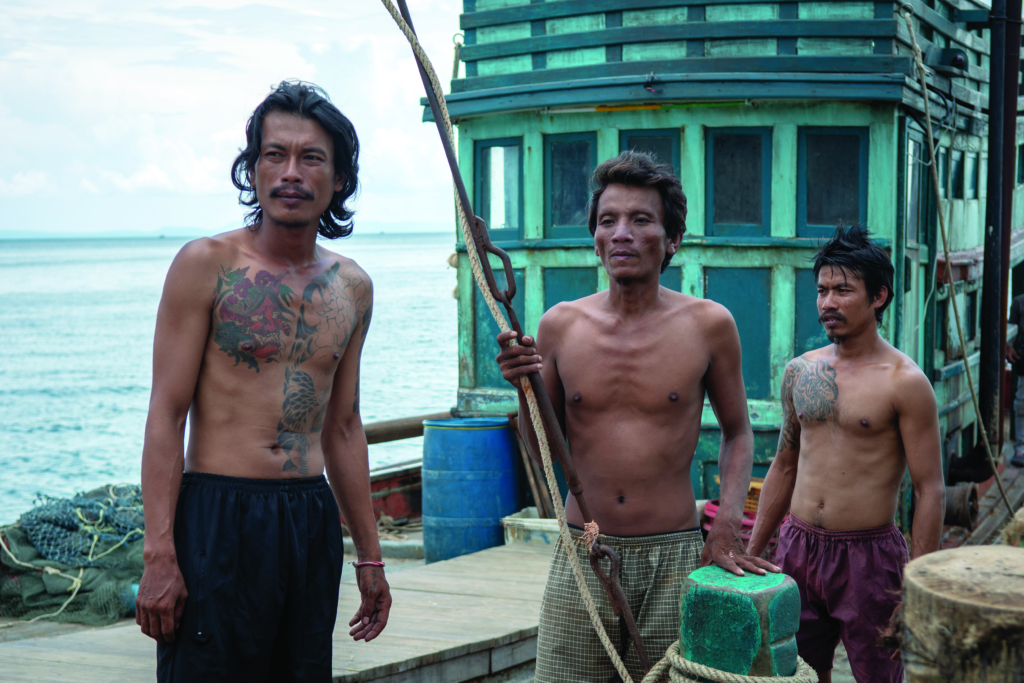
Food for thought
When we meet in the vast, glass-roofed food court of Melbourne’s Collins Place, just outside the Kino cinema, where Buoyancy is about to have its MIFF screening, Rathjen chuckles at his inability to make life easy for himself or his crew. ‘When I started writing it, I didn’t really think of the consequences […] which was good, because I might not have ever written it.’ There was the language barrier again, this time as he was working with a predominantly non-professional cast hailing from Cambodia, Myanmar and Thailand. Three of the shoot’s five weeks were also spent on the stomach-churning high seas, with most of the rest on Koh Rong Sanloem island, minus mobile reception. ‘Everybody was freaking out,’ Rathjen recalls of the vomit-inducing conditions that meant seasickness tablets were distributed en masse.
I got crook on the first reccie, and we lost our second [director of photography] on the first day. We never saw her again after that. But then [the crew each] took one seasickness pill in the morning and one in the middle of the day and got through the rest of the shoot relatively unscathed.
Although it was a logistical challenge, the project, according to Rathjen, was ultimately worth it. ‘When you get into it and actually start the production, you find a path through those obstacles and they never seem as bad as what you initially thought,’ he muses. The resulting work has not disappointed; screening in the Panorama stream at Berlinale, Buoyancy won the Prize of the Ecumenical Jury and was nominated for a clutch more awards, including Best First Feature.
While Buoyancy and Tau Seru are set in worlds far removed from Colbinabbin – the central Victorian town where Rathjen grew up – there’s a kernel of the director’s own truth in these stories about young men dreaming of a bigger life beyond the horizon. Rathjen himself upped sticks and moved to Melbourne to study film, graduating from the Victorian College of the Arts (VCA), and has been fascinated by stories beyond his own backyard ever since. He is also an alumnus of MIFF’s Accelerator Lab program, which would pave the way for his feature debut receiving finance from the MIFF Premiere Fund.
Buoyancy was inspired by a 2014 Environmental Justice Foundation report[3]Environmental Justice Foundation, Slavery at Sea: The Continued Plight of Trafficked Migrants in Thailand’s Fishing Industry, London, 2014, <https://ejfoundation.org//resources/downloads/EJF_Slavery-at-Sea_report_2014_web-ok.pdf>, accessed 30 October 2019. and a 2015 exposé by the Associated Press that uncovered that hundreds of slaves had been detained in a prison camp in the Indonesian island village of Benjina. Held in cages and forced to work almost nonstop without proper access to clean water or sanitation, they were tasered or lashed with poisonous stingray tails if their labour ever slowed.[4]For the full extent of the reportage, see ‘Seafood from Slaves: An AP Investigation Helps Free Slaves in the 21st Century’, AP Explore, <https://www.ap.org/explore/seafood-from-slaves/>, accessed 30 October 2019. With so much opaqueness to many aspects of the international seafood industry, Rathjen notes that it’s almost impossible to know how much ill-gotten product ends up on Australian plates. This uncertainty then compelled him to begin work on Buoyancy: ‘I was shocked and felt really naive that I didn’t know more about [the issue].’
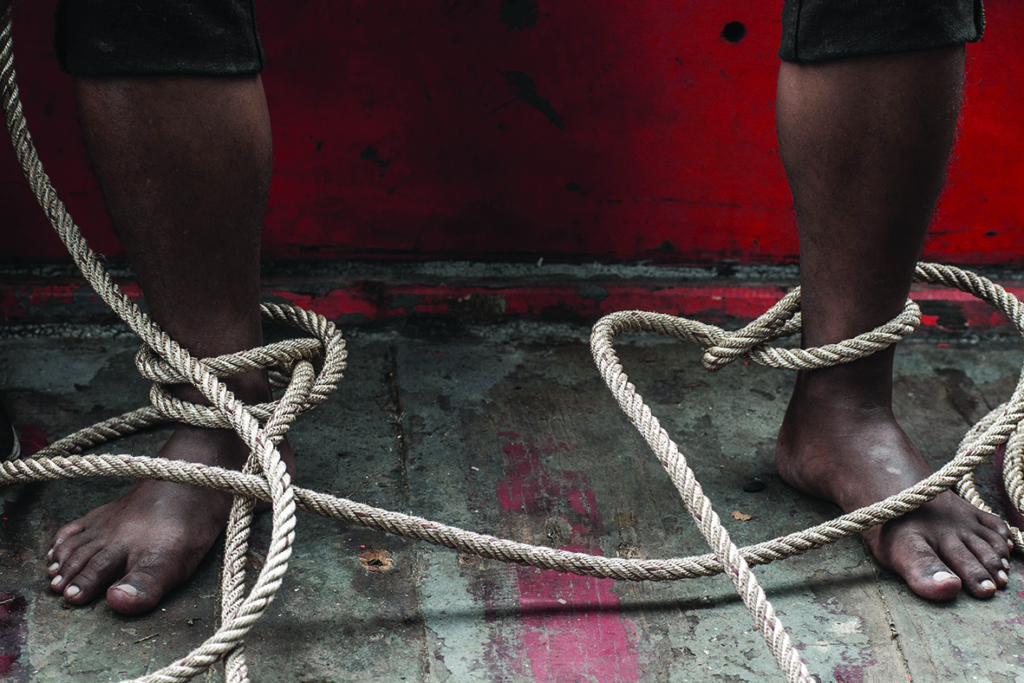
Consumed by research and working with non-government organisations (NGOs) in Thailand and Cambodia, he interviewed fifty-plus survivors in person. ‘I thought a film would be a great way of bringing their voices to the world, because they’re absolutely voiceless out there on the water.’ Rathjen also spoke to former captains, bureaucrats struggling to get a handle on the issue and bereft families who had lost loved ones to these slavers.
While there is a valid conversation to be had about who should get to tell the story of the freed fishermen, Rathjen says he received enthusiastic support from them. He wonders if the film would have happened otherwise: ‘Cambodia doesn’t really have the filming infrastructure or support and encouragement to make a film as challenging as this,’ he notes.
It was devastating to listen to these guys and their stories. And they would plead with me to make a film about it, because they didn’t think they were being heard, and they wanted to do something about it. They’re my inspiration for making the film.
Truth to power
Kasro – one of the few professional actors on set, and a director himself – drew on his personal experiences working on a trawler from the ages of eleven to thirteen. ‘Being exposed to it at such an impressionable age, it has this lasting impact on you and Than brought a lot of that point of view,’ Rathjen says. The actor also roped in several of his trawler companions with him, now gainfully employed by Kasro’s film-production company in Thailand.
‘I wanted to understand the cycle of violence and how you become capable of such inhumane acts … So, for me, it was just placing a thought in the audience’s head – that Chakra could go in Rom Ran’s direction if he’s not careful.’
—Rodd Rathjen
The complicated relationship between Chakra and Rom Ran is a huge part of why Buoyancy works so well, as the young lad attempts to win his abuser’s respect. Writing for ABC News, critic Luke Goodsell dubbed the latter a ‘terrifying, low-rent [James] Bond villain’ and praised the portrayal of the former as having the ‘kind of expressive stillness necessary to take all these horrors in’.[5]Luke Goodsell, ‘Modern Slavery and People Smuggling Form Backdrop to South-East Asia–set Australian Film Buoyancy’, ABC News, 24 September 2019, <https://www.abc.net.au/news/2019-09-24/buoyancy-review-modern-slavery-people-smuggling-south-east-asia/11529738>, accessed 30 October 2019. Rathjen deliberately played with the audience’s understanding of the pair’s twisted dynamic: ‘I wanted to understand the cycle of violence and how you become capable of such inhumane acts.’ As he sees it, the captain looks at Chakra and sees something of himself as a young man, captured in similar circumstances. ‘So, for me,’ Rathjen continues, ‘it was just placing a thought in the audience’s head – that Chakra could go in Rom Ran’s direction if he’s not careful.’ Likewise, Chakra’s distancing of himself from the weakening Kea is insightful from a storytelling standpoint. ‘Chakra’s relationship with Kea is really pivotal in showing how one person’s kind of holding on and the other’s losing their grip,’ Rathjen says. ‘That dynamic was really important as well.’
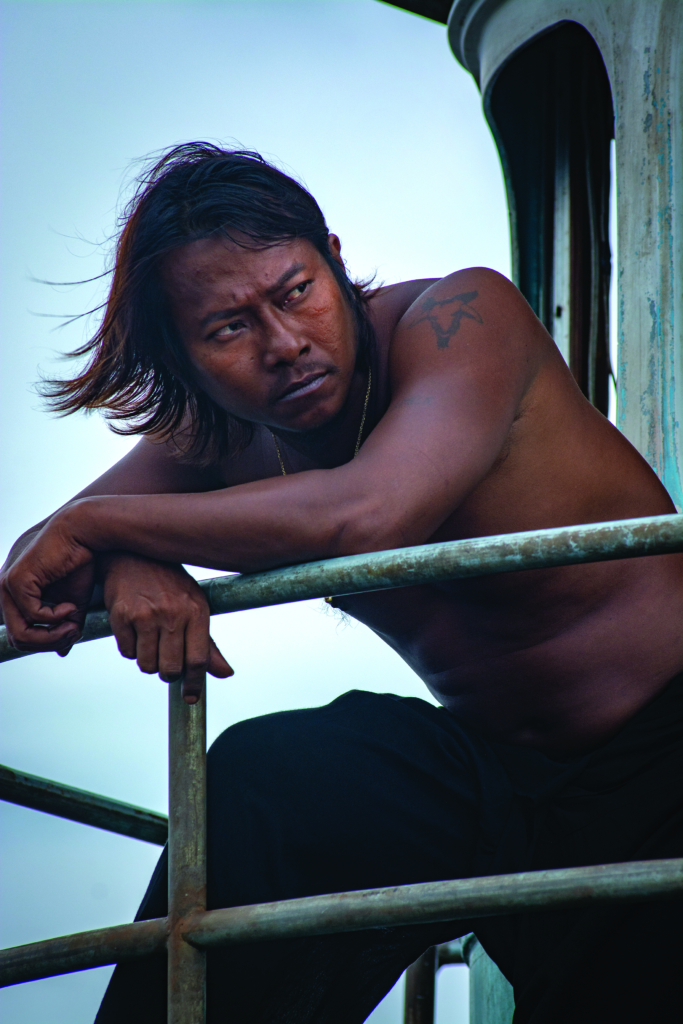
Heng is a revelation; remarkably, Buoyancy is his first foray into acting. A deeply intuitive performer, he is gifted with a wonderfully expressive face that conveys so much of his character’s wistful dreaming, deep trauma and small, hard-won victories. Rathjen was staggered by the young actor’s ability to communicate so much with so few spoken words.
He was really uninhibited and strong and tough, but cheeky as well. The camera didn’t faze him and he’s very photogenic, so he just encompassed the character, that determination, the need for independence […] I thought we were gonna cast someone older, with more life experience, but he had that in spades already.
An orphan raised by Siem Reap–based NGO the Green Gecko Project, which supports street children and their families, Heng was found living in poverty. The organisation took him in and provided housing and education. When casting director Raweeporn ‘Non’ Srimonju approached Green Gecko Project founder Tania Palmer about working with Heng, Rathjen recalls that she was initially reluctant.
They’d done a lot of stunt work on Angelina Jolie’s First They Killed My Father [2017] and Tania was like, ‘No, it ruined the kids, taking them out of school for three months.’ But, when we told her the story and what we were doing, she was like, ‘Yeah, okay, let’s do this.’
Heng took on the mantle of actor with ease, Rathjen notes, slipping seamlessly into character and adeptly tracking Chakra’s journey even while filming sequences out of order – all with only minimal assistance from Srimonju, who slipped into on-set-translator mode. ‘He’s pretty natural in front of the camera,’ Rathjen says,
so I didn’t feel like I had to do a hell of a lot with him. There were some really challenging emotional and psychological moments we had to work hard at. But, for the most part, I think, with his experience as a kid, he encompassed that determination and the courage I see in his face throughout the film.
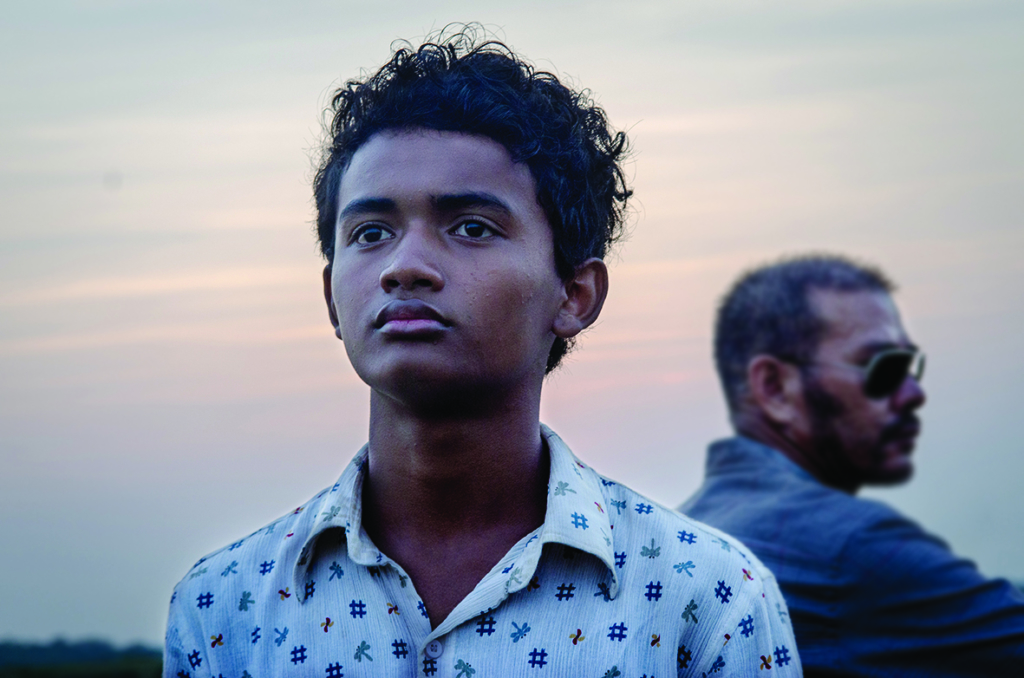
Think and digest
Rathjen was careful to craft Buoyancy such that it would work both as a political wake-up call for consumers oblivious to the possibly dark machinations behind their fish suppers and as a gripping (mis)adventure on the high seas – albeit without the massive explosions, constant shouting and excessive violence of most Hollywood action fare. Not that there isn’t gruelling cruelty; it’s just that much of the brutality that occurs is implied, rather than gorily rendered. For Rathjen, this aspect of the film makes it arguably more chilling:
When you’re forcing the audience to imagine what’s going on, that can sometimes be more traumatic, in a way. And, as I said, the film’s confronting enough. We still want people to go and watch it, so we’re trying to build the tension in a way that’s engaging, but not so much that you couldn’t bear to watch it.
When I ask him about influences on the film and his career, Rathjen surprises me with one nod in particular: Steve McQueen’s Hunger (2008). ‘It’s not so much the tension,’ he clarifies. ‘It’s more in terms of visual pace. That film’s got this huge subtext in dealing with human beings under really extreme conditions and the dehumanisation process.’ Indeed, much like in McQueen’s Hunger or 12 Years a Slave (2013), the trauma in Buoyancy is wrapped in very beautiful cinematic packaging. From the bluish-pink smudge of sunset over the sea, to the lush rural greenery, to the half-glimpsed neon sparkle of the city, Rathjen wanted to offer viewers a visual escape from all the intensity.
The sea is spiritual and I wanted to give the audience a break from what was happening on board the boat. So we were just trying to craft a poetic balance between the tension and the violence with this kind of stillness and quiet.
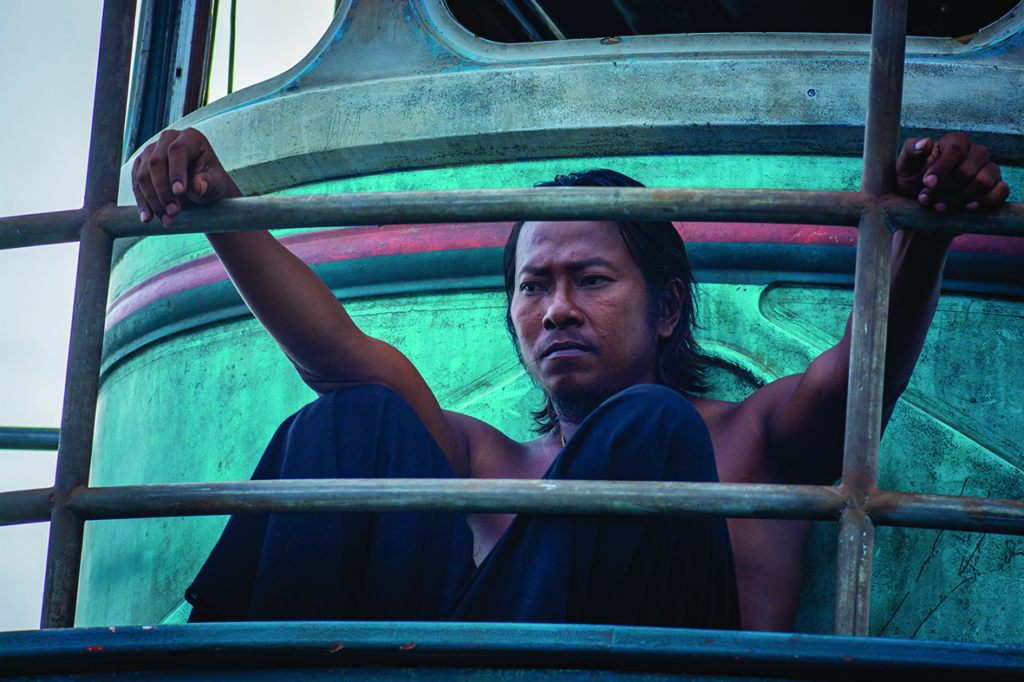
He’s ably assisted in this endeavour by remarkable Australian cinematographer – and fellow VCA alumnus – Michael Latham, who brought a similar glow to Alena Lodkina’s transfixing opal-mine drama Strange Colours (2017) and Gabrielle Brady’s haunting detention-centre documentary Island of the Hungry Ghosts (2018). Both films share Buoyancy’s interest in traumatic interpersonal relations and disorienting remoteness of place. Latham lends these films a visual language that thrums alongside their rivetingly paced stories.
Following its global festival and Australian theatrical run, Buoyancy screened in Cambodia, where Rathjen hopes it will ‘act as a deterrent to those from vulnerable communities who are thinking about making the move to Thailand’.[6]Rodd Rathjen, quoted in ‘Buoyancy – Q&A with Director Rodd Rathjen’, MIFF Blog, 10 July 2019, <http://miff.com.au/blog/view/4394/buoyancy-director-rodd-rathjen-qa>, accessed 30 October 2019. With the film announced as Australia’s entry for Best International Feature Film at the 2020 Academy Awards,[7]‘Buoyancy Submitted for Best International Feature Film at 2020 Academy Awards’, media release, Screen Australia, 26 September 2019, <https://www.screenaustralia.gov.au/sa/media-centre/news/2019/09-26-buoyancy-submitted-academy-awards>, accessed 30 October 2019. it’s poised to reach even more audiences across the globe. As for audiences at home, he intends for it to prompt us to consider the impact of our seafood purchases – a message that will only be strengthened by the filmmakers’ campaign alongside social-justice organisation Be Slavery Free to improve product labelling so as to ‘identify where it has come from and under what conditions it was caught’.[8]Karl Quinn, ‘Net Prophets: Anti-slavery Campaign Calls for Clear Labelling of Seafood’, The Age, 8 October 2019, <https://www.theage.com.au/culture/movies/net-prophets-anti-slavery-campaign-calls-for-clear-labelling-of-seafood-20191007-p52yem.html>, accessed 30 October 2019. ‘Absolutely, we’re part of the supply-and-demand chain,’ Rathjen asserts, ‘but traceability is a real issue. One of the reasons for making the film is so that we can become more conscious consumers.’
Endnotes
| 1 | It was one of only two Australian titles slated for the festival that year, alongside opening-night (non-competition) film The Great Gatsby (Baz Luhrmann, 2013). |
|---|---|
| 2 | Rodd Rathjen, quoted in ‘Australian Short Tau Seru Selected for Cannes’, media release, Screen Australia, 23 April 2013, <https://www.screenaustralia.gov.au/sa/media-centre/news/2013/04-23-tau-seru-selected-for-cannes>, accessed 30 October 2019. |
| 3 | Environmental Justice Foundation, Slavery at Sea: The Continued Plight of Trafficked Migrants in Thailand’s Fishing Industry, London, 2014, <https://ejfoundation.org//resources/downloads/EJF_Slavery-at-Sea_report_2014_web-ok.pdf>, accessed 30 October 2019. |
| 4 | For the full extent of the reportage, see ‘Seafood from Slaves: An AP Investigation Helps Free Slaves in the 21st Century’, AP Explore, <https://www.ap.org/explore/seafood-from-slaves/>, accessed 30 October 2019. |
| 5 | Luke Goodsell, ‘Modern Slavery and People Smuggling Form Backdrop to South-East Asia–set Australian Film Buoyancy’, ABC News, 24 September 2019, <https://www.abc.net.au/news/2019-09-24/buoyancy-review-modern-slavery-people-smuggling-south-east-asia/11529738>, accessed 30 October 2019. |
| 6 | Rodd Rathjen, quoted in ‘Buoyancy – Q&A with Director Rodd Rathjen’, MIFF Blog, 10 July 2019, <http://miff.com.au/blog/view/4394/buoyancy-director-rodd-rathjen-qa>, accessed 30 October 2019. |
| 7 | ‘Buoyancy Submitted for Best International Feature Film at 2020 Academy Awards’, media release, Screen Australia, 26 September 2019, <https://www.screenaustralia.gov.au/sa/media-centre/news/2019/09-26-buoyancy-submitted-academy-awards>, accessed 30 October 2019. |
| 8 | Karl Quinn, ‘Net Prophets: Anti-slavery Campaign Calls for Clear Labelling of Seafood’, The Age, 8 October 2019, <https://www.theage.com.au/culture/movies/net-prophets-anti-slavery-campaign-calls-for-clear-labelling-of-seafood-20191007-p52yem.html>, accessed 30 October 2019. |
